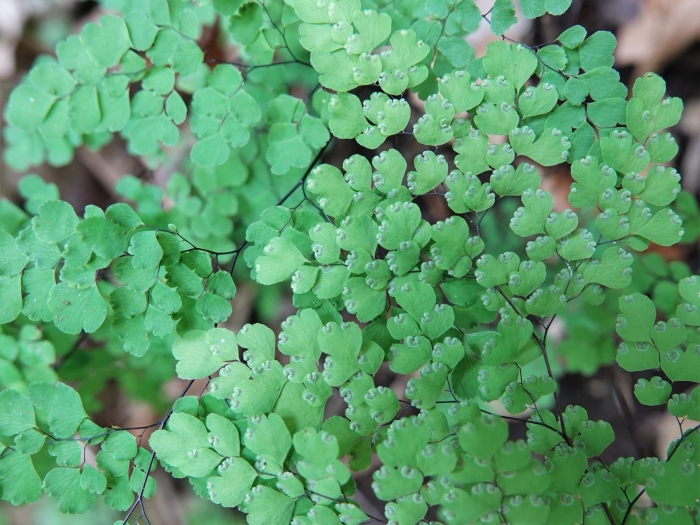Delta Maidenhair Fern
(Adiantum raddianum)
Delta Maidenhair Fern (Adiantum raddianum)
/
/

Jacqui Geux
CC BY 4.0
Image By:
Jacqui Geux
Recorded By:
Copyright:
CC BY 4.0
Copyright Notice:
Photo by: Jacqui Geux | License Type: CC BY 4.0 | License URL: http://creativecommons.org/licenses/by/4.0/ | Rights Holder: Jacqui Geux | Publisher: iNaturalist | Date Created: 2019-01-01T13:05:19-08:00 |

























Estimated Native Range
Summary
Adiantum raddianum, commonly known as Delta maidenhair fern, is a perennial herbaceous plant native to the tropical rainforests of South America. It thrives in the understory of these forests, where it enjoys the dappled sunlight and high humidity. This fern typically grows to about 17-19 inches tall and can spread up to 22 inches wide. Its delicate, fan-shaped fronds are supported by shiny, dark, wiry stems that resemble human hair, giving the plant its common name. The fronds are comprised of small, triangular leaflets, which contribute to the fern’s airy and elegant appearance.
Delta maidenhair fern is celebrated for its graceful form and is often used as an ornamental houseplant. It requires a consistently moist environment, making it ideal for terrariums or as a bathroom plant where humidity is naturally higher. While it prefers bright, indirect light, it can tolerate lower light levels, which adds to its versatility as an indoor plant. In terms of temperature, it is hardy down to 5°C and is suitable for USDA zones 10 and 11. Gardeners should be vigilant for pests such as scale and mealybugs, which can be managed with regular inspection and treatment if necessary. This fern has earned the Royal Horticultural Society’s Award of Garden Merit, indicating its value in cultivation. However, it can become invasive in some regions when grown outdoors, so care should be taken to prevent its spread in non-native areas.CC BY-SA 4.0
Delta maidenhair fern is celebrated for its graceful form and is often used as an ornamental houseplant. It requires a consistently moist environment, making it ideal for terrariums or as a bathroom plant where humidity is naturally higher. While it prefers bright, indirect light, it can tolerate lower light levels, which adds to its versatility as an indoor plant. In terms of temperature, it is hardy down to 5°C and is suitable for USDA zones 10 and 11. Gardeners should be vigilant for pests such as scale and mealybugs, which can be managed with regular inspection and treatment if necessary. This fern has earned the Royal Horticultural Society’s Award of Garden Merit, indicating its value in cultivation. However, it can become invasive in some regions when grown outdoors, so care should be taken to prevent its spread in non-native areas.CC BY-SA 4.0
Plant Description
- Plant Type: Fern
- Height: 1-2 feet
- Width: 1-2 feet
- Growth Rate: Moderate
- Flower Color: N/A
- Flowering Season: Non-Flowering
- Leaf Retention: Evergreen
Growth Requirements
- Sun: Part Shade
- Water: Medium
- Drainage: Medium, Slow
Common Uses
Bird Garden, Border Plant, Butterfly Garden, Groundcover, Hummingbird Garden, Low Maintenance, Potted Plant
Natural Habitat
Native to the understory of tropical rainforests in South America
Other Names
Common Names: Fragile Fern , Delta Maidenhair Fern , Southern Maidenhair Fern , Fairy Fern
Scientific Names: Adiantum raddianum , Adiantum aemulum , Adiantum aethiopicum , Adiantum aethiopicum , Adiantum baenitzii , Adiantum colpoides , Adiantum cuneatum , Adiantum cuneatum , Adiantum cuneatum f. elongatum , Adiantum cuneatum f. typicum
GBIF Accepted Name: